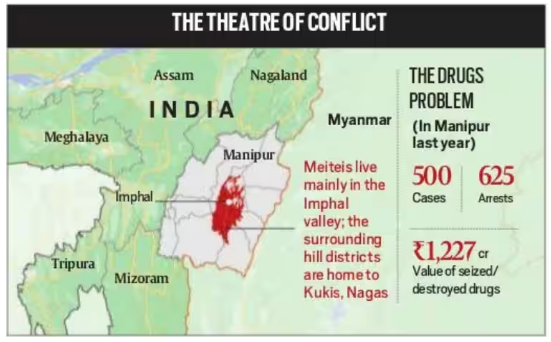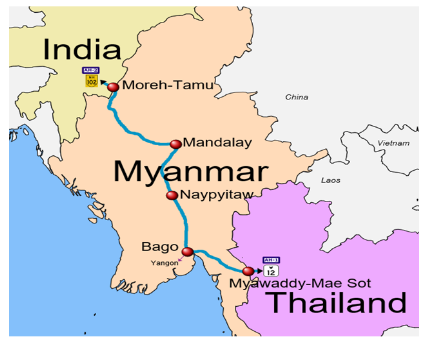Context:
Recently, in the ongoing ethnic conflict between Meiteis and Kukis in Manipur, questions also have been raised on the Free Movement Regime (FMR) that facilitates migration across the IMB.
- Also, during the 12th Mekong Ganga Cooperation (MGC) meeting in Bangkok on July 16, Indian External Affairs Minister held a meeting with his Myanmar counterpart.
- The main focus of their discussion was regional connectivity projects, with a special emphasis on fast-tracking the India-Myanmar-Thailand Trilateral Highway (IMT-TH) initiative.
 Image Source: Indian Express
Image Source: Indian Express
About Free Movement Regime (FMR) on the Indo-Myanmar Border (IMB):
- The border between India and Myanmar runs for 1,643 km in the four states of Mizoram, Manipur, Nagaland, and Arunachal Pradesh.
- The FMR is a mutually agreed arrangement between the two countries that allows tribes living along the border on either side to travel up to 16 km inside the other country without a visa.
| Main Issues |
Free Movement Regime (FMR) |
Challenges Posed by the FMR |
Proposed Solutions for Addressing Challenges |
| Ongoing Ethnic Conflict in Manipur |
Conceptualization: Implemented in 2018 as part of the Act East Policy |
Unintentional aiding of Illegal Immigration |
Better Regulation of FMR |
| Complicated by Illegal Migration of Kuki-Chin |
Travel Permit: Allows travel without a visa up to 16 km |
Refugee Influx: Triggered by Myanmar’s military coup |
Middle Path: Addressing socio-political-economic changes |
| Aiding drug trafficking, and gun running |
Ethnic & Cultural ties: Border demarcation split same ethnicity |
Deforestation & Tensions: Manipur’s Concerns |
Tackling the issue: Balancing concerns & needs |
|
Significance: Facilitates people-to-people contact & local trade |
Resistance to eviction: Triggered Violence |
Inclusion of the Local Population |
|
Discontinuation: Suspended in September 2022 due to Myanmar crisis |
|
|
About India-Myanmar-Thailand Trilateral Highway Project:
 Image Source: PWOnlyIAS Video
Image Source: PWOnlyIAS Video
- Connectivity Initiative: The India-Myanmar-Thailand Trilateral Highway (IMT-TH) project is a significant regional connectivity initiative aimed at establishing a road network that links India’s Northeast region with Thailand through Myanmar.
- Objective: Its primary objective is to bolster trade, commerce, tourism, and people-to-people interactions among the three countries, fostering regional integration and collaboration.
- Coverage in India: Within India, the highway is anticipated to traverse through Moreh, Kohima, Guwahati, Srirampur, Siliguri, and Kolkata, covering a total distance of over 2,800 kilometers.
- Share of Highway Stretch: The Indian section will constitute the longest stretch of the highway, while the smallest road segment will be in Thailand.
Importance of the IMT-TH Project:
- Improved Connectivity: The IMT-TH project is designed to enhance connectivity between India’s Northeast region, Myanmar, and Thailand, resulting in reduced travel time and transportation costs.
- This smooth movement of goods, services, and people across borders fosters better regional integration.
- Boost to Trade and Commerce: The highway acts as a major catalyst for trade and commerce among the three nations.
- By creating new markets and opportunities for businesses, it facilitates the flow of goods and services, contributing to economic growth in the region.
- Tourism Promotion: The improved road connectivity from the IMT-TH project is expected to bolster tourism between India, Myanmar, and Thailand.
- Simplified travel and cultural exchange will attract more tourists, leading to economic benefits for the tourism industry in each country.
- Regional Integration and Cooperation: The project strengthens regional ties by fostering cooperation between India, Myanmar, and Thailand.
- It encourages joint ventures and partnerships for mutual socio-economic development, enhancing bilateral and multilateral relationships.
- Socio-economic Development: The IMT-TH project has the potential to bring about socio-economic development in the areas it traverses.
- Better accessibility to healthcare, education, and essential services can improve the quality of life for local communities.
- Reinforcement of India’s Act East Policy: The project aligns with India’s Act East Policy, aimed at deepening engagement with Southeast Asian countries.
- By demonstrating commitment to regional cooperation and connectivity, the IMT-TH highway supports the objectives of this policy.
- Regional Stability and Prosperity: Promoting economic cooperation and connectivity, the IMT-TH project contributes to regional stability and prosperity.
- Geopolitical Implications: The project’s significance extends to geopolitical realms as it connects the Indian subcontinent with mainland Southeast Asia.
- It offers an alternative trade route, reducing reliance on traditional maritime paths and providing strategic advantages to the participating countries.
- Cultural Exchange and People-to-People Connectivity: The enhanced connectivity through the highway promotes cultural exchange and people-to-people interactions among the nations.
- This exchange of ideas, traditions, and experiences can lead to greater mutual understanding and collaboration.
- Infrastructure Development: The construction and maintenance of the IMT-TH highway contribute to significant infrastructure development in the involved countries.
Major Challenges with the Project:
- Incomplete Road Network: While some parts of the highway have seen completion or upgrades, certain sections still require significant progress.
- Urgent attention is needed to address the delay in replacing 69 bridges along the Tamu-Kyigone-Kalewa road in Myanmar, which has been pending since 2015.
- Construction Difficulties: The Yar Gyi road segment presents considerable construction challenges due to its steep gradients and sharp curves.
- Transforming a 121.8-km portion of the road into a four-lane motorway between Kalewa and Yar Gyi is taking more time than originally anticipated.
- Security Concerns: The ongoing conflict between the junta and ethnic armed groups in Myanmar’s Chin State and Sagaing Region poses significant security risks for contractors, leading to uncertainty regarding the resumption of construction work.
- Implementation of the IMT Trilateral Motor Vehicle Agreement:
- Smooth cross-border transportation and the effective implementation of the agreement among the three nations face several hurdles.
- Infrastructure limitations, bureaucratic complexities, and security concerns hinder the process.
- Obtaining permits and clearances remains challenging due to differences in vehicle movement rules and procedures in each country.
- Land Acquisition and Compensation: Acquiring the necessary land for highway construction and compensating affected communities can be a complex and time-consuming process.
- Disputes over land ownership and compensation rates may lead to delays and legal issues.
- Funding and Financial Constraints: The ambitious nature of the project requires significant financial resources.
- Ensuring sustained funding and managing cost overruns can be a challenge, particularly in the context of economic uncertainties and competing infrastructure priorities.
- Impact on Local Communities: The construction and operation of the highway may bring socio-economic changes to local communities, both positive and negative.
- Ensuring that the project benefits local populations while minimizing any adverse effects is a critical consideration.
The Path Ahead: Essential Factors for Successful Implementation
- Infrastructure Development: Resolving Myanmar’s infrastructure limitations is of utmost importance to facilitate seamless vehicle movement between India, Myanmar, and Thailand.
- Sufficient funding and resource allocation are imperative to overcome these obstacles effectively.
- Policy Coordination: Establishing robust policy coordination with ASEAN concerning Myanmar is critical for a comprehensive approach to regional matters and creating a stable environment conducive to connectivity initiatives.
- Commitment to Democratic Transition: India’s dedication to supporting Myanmar’s democratic transition process and its emphasis on peace and stability hold significant significance for the advancement and prosperity of the entire region.
- Multilateral Cooperation and Engagement: Encouraging greater multilateral cooperation among India, Myanmar, Thailand, and other regional stakeholders is essential for the successful implementation of the project.
- Regular dialogues, joint forums, and collaborative efforts are must for implementation to be successful .
| Additional Information:
About Mekong Ganga Cooperation (MGC):
- Established: It was established in 2000, at Vientiane, Laos at the First MGC Ministerial Meeting.
- Composition: It comprises six member countries, namely India, Thailand, Myanmar, Cambodia, Laos and Vietnam.
- Areas of Cooperation: The four areas of cooperation are tourism, culture, education, transportation and communication.
- Aim: Both the Ganga and the Mekong are civilizational rivers, and the MGC initiative aims to facilitate closer contact among the people inhabiting these two major river basins.
|
News Source: The Indian Express
![]() 31 Jul 2023
31 Jul 2023
 Image Source: Indian Express
Image Source: Indian Express Image Source: PWOnlyIAS Video
Image Source: PWOnlyIAS Video